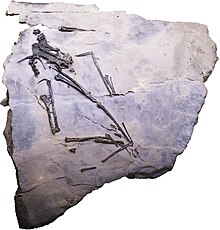Raeticodactylus
| Raeticodactylus | |
|---|---|

| |
| Fossil in Bündner Naturmuseum | |
| Scientific classification | |
| Domain: | Eukaryota |
| Kingdom: | Animalia |
| Phylum: | Chordata |
| Order: | †Pterosauria |
| Family: | †Raeticodactylidae |
| Genus: | †Raeticodactylus Stecher, 2008 |
| Species: | †R. filisurensis
|
| Binomial name | |
| †Raeticodactylus filisurensis Stecher, 2008
| |
Raeticodactylus is a
Description
Raeticodactylus had a tall thin bony crest running along the midline of the front of the upper jaw, and a keel on the lower jaw; however, it does not seem to be closely related to Austriadactylus, the only other crested Triassic pterosaur named by the time Raeticodactylus was described. The teeth at the front of the upper jaw, in the premaxillae, were fanglike, whereas the teeth in the upper cheeks (the maxillae) had three, four, or five cusps, similar to those of Eudimorphodon. Raeticodactylus had a wingspan of about 135 centimeters (53 in), and may have been a piscivore, potentially feeding by skimming the water.[1] However, skim-feeding has since been disproven in pterosaurs, and the related Caviramus appears to have been an omnivore.[3]
Classification
A 2009 study by Fabio Dalla Vecchia, which analyzed the relationships within the family
A study by
| Eopterosauria |
| ||||||||||||||||||||||||||||||||||||||||||
In 2020 however, a study upheld by Matthew G. Baron about early pterosaur interrelationships found Raeticodactylus to group with
See also
References
- ^ S2CID 128980861. Online First
- ^ Müller R.T., Ezcurra M.D., Garcia M.S., Agnolín F.L., Stocker M.R., Novas F.E., Soares M.B., Kellner A.W.A. & Nesbitt S.J. (2023). ”New reptile shows dinosaurs and pterosaurs evolved among diverse precursors”. Nature 620(7974): p. 589–594. doi:10.1038/s41586-023-06359-z
- ISBN 0691150613.
- ^ Dalla Vecchia, F.M. (2009). "Anatomy and systematics of the pterosaur Carniadactylus (gen. n.) rosenfeldi (Dalla Vecchia, 1995)". Rivista Italiana de Paleontologia e Stratigrafia. 115 (2): 159–188.
- PMID 33005485.
